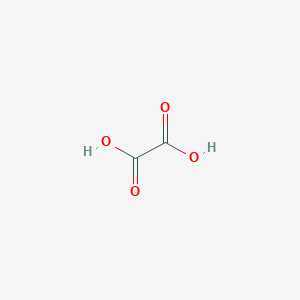Details of Metabolite
| Full List of Protein(s) Regulating This Metabolite | ||||||
|---|---|---|---|---|---|---|
| Lyases (EC 4) | ||||||
| Dihydrodipicolinate synthase-like (DHDPSL) | Click to Show/Hide the Full List of Regulating Pair(s): 1 Pair(s) | |||||
| Detailed Information |
Protein Info
 click to show the details of this protein click to show the details of this protein
|
|||||
| Regulating Pair |
Experim Info
 click to show the details of experiment for validating this pair click to show the details of experiment for validating this pair
|
[1] | ||||
| Introduced Variation | Mutation (patients: bi-allelic mutations) of HOGA1 | |||||
| Induced Change | Oxalic acid concentration: increase | |||||
| Summary | Introduced Variation
|
|||||
| Disease Status | Carbohydrate metabolism disorders [ICD-11: 5C51] | |||||
| Details | It is reported that mutation (patients with bi-allelic mutations) of HOGA1 leads to the increase of oxalic acid levels compared with control group. | |||||
| Oxidoreductases (EC 1) | ||||||
| Glyoxylate reductase/hydroxypyruvate reductase (GRHPR) | Click to Show/Hide the Full List of Regulating Pair(s): 1 Pair(s) | |||||
| Detailed Information |
Protein Info
 click to show the details of this protein click to show the details of this protein
|
|||||
| Regulating Pair |
Experim Info
 click to show the details of experiment for validating this pair click to show the details of experiment for validating this pair
|
[2] | ||||
| Introduced Variation | Mutation (patients: c.454dup (p.Thr152Asnfs*39)) of GRHPR | |||||
| Induced Change | Oxalic acid concentration: increase | |||||
| Summary | Introduced Variation
|
|||||
| Disease Status | Carbohydrate metabolism disorders [ICD-11: 5C51] | |||||
| Details | It is reported that mutation (patients with c.454dup (p.Thr152Asnfs*39)) of GRHPR leads to the increase of oxalic acid levels compared with control group. | |||||
| Sulfate permease (SULP) | ||||||
| Solute carrier family 26 member 1 (SLC26A1) | Click to Show/Hide the Full List of Regulating Pair(s): 1 Pair(s) | |||||
| Detailed Information |
Protein Info
 click to show the details of this protein click to show the details of this protein
|
|||||
| Regulating Pair |
Experim Info
 click to show the details of experiment for validating this pair click to show the details of experiment for validating this pair
|
[3] | ||||
| Introduced Variation | Overexpression of SLC26A1 | |||||
| Induced Change | Oxalic acid concentration: increase (FC = 6) | |||||
| Summary | Introduced Variation
|
|||||
| Disease Status | Healthy individual | |||||
| Details | It is reported that overexpression of SLC26A1 leads to the increase of oxalic acid levels compared with control group. | |||||
| Solute carrier family 26 member 6 (SLC26A6) | Click to Show/Hide the Full List of Regulating Pair(s): 1 Pair(s) | |||||
| Detailed Information |
Protein Info
 click to show the details of this protein click to show the details of this protein
|
|||||
| Regulating Pair |
Experim Info
 click to show the details of experiment for validating this pair click to show the details of experiment for validating this pair
|
[4] | ||||
| Introduced Variation | Knockdown (siRNA) of SLC26A6 | |||||
| Induced Change | Oxalic acid concentration: decrease (FC = 0.60) | |||||
| Summary | Introduced Variation
|
|||||
| Disease Status | Colon cancer [ICD-11: 2B90] | |||||
| Details | It is reported that knockdown of SLC26A6 leads to the decrease of oxalic acid levels compared with control group. | |||||
| Transferases (EC 2) | ||||||
| Deacetylase sirtuin-5 (SIRT5) | Click to Show/Hide the Full List of Regulating Pair(s): 1 Pair(s) | |||||
| Detailed Information |
Protein Info
 click to show the details of this protein click to show the details of this protein
|
|||||
| Regulating Pair |
Experim Info
 click to show the details of experiment for validating this pair click to show the details of experiment for validating this pair
|
[5] | ||||
| Introduced Variation | Knockout of Sirt5 | |||||
| Induced Change | Oxalic acid concentration: increase (FC = 1.34) | |||||
| Summary | Introduced Variation
|
|||||
| Disease Status | Healthy individual | |||||
| Details | It is reported that knockout of Sirt5 leads to the increase of oxalic acid levels compared with control group. | |||||
If you find any error in data or bug in web service, please kindly report it to Dr. Zhang and Dr. Mou.

